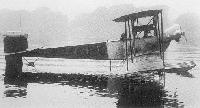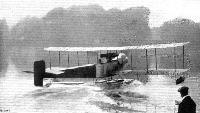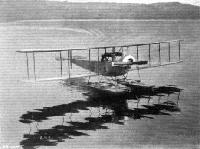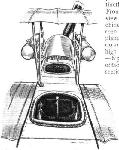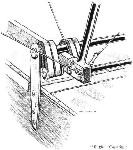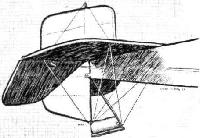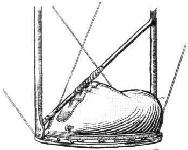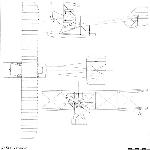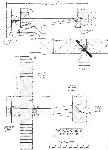A.Jackson Avro Aircraft since 1908 (Putnam)
The Duigan Biplane
<...>
Having achieved his objectives, Duigan returned home. There he built a very similar machine to the Avro which crashed on its first flight on February 17, 1913. His British aeroplane was put up for sale with engine for £380 but was almost immediately reduced to £180, no doubt because the engine had been sold separately. The airframe was purchased by the Lakes Flying Company and it was delivered to Windermere on June 4, 1912. Here it was rebuilt as the centre float seaplane Sea Bird which H. Stanley Adams flew off the lake for the first time on August 28, 1912. The company entirely redesigned the front end of the fuselage to accept a 50 hp Gnome rotary, the upper half of which was cowled and gave a cocked-up appearance to the nose. New three-bay, warping mainplanes of Eiffel 12 section and 8-5 aspect ratio were also fitted. The machine proved much faster than the old Avro-built Water Bird and after it has been fitted with an improved twin float undercarriage, carried large numbers of holiday makers during 1912-13.
At the end of 1912 the machine was tested with an amphibious undercarriage but trials came to an end on December 18, 1912, when Sea Bird piloted by Lt J.F.A. Trotter was caught by a gust of wind and the lower port wing struck the water. In January 1915 the Lakes Flying Company was taken over by the Northern Aircraft Company Ltd and thereafter the machine was generally referred to as the Avro Biplane Tractor. It was equipped with dual control soon after and at the beginning of June was fitted with new floats. Unfortunately, pupil R. Buck took off in the Avro for his Vol-plane test on June 5 unaware that the latter had altered the centre of gravity. On switching off the engine to begin his glide approach, Buck failed to lower the nose sufficiently and the machine stalled at 300 ft, crashing into the lake tail first. Miraculously Buck was unhurt but the Sea Bird was destroyed.
SPECIFICATION AND DATA
Manufacturers: A. V. Roe and Company, Brownsfield Mills, Great Ancoats Street, Manchester; and Brooklands Aerodrome, Byfleet, Surrey.
Rebuilt by The Lakes Flying Company, Cockshott, Lake Windermere, Westmorland
Power Plants:
(Sea Bird) One 50 h.p. Gnome
Dimensions:
(Sea Bird) Span 39 ft. 4 in. Length 29 ft. 4 in.
Height 10 ft. 6 in. Wing area 350 sq. ft.
Performance:
(Sea Bird) Maximum speed 62 m.p.h.
Production: One aircraft only, first flown 2.12; converted into the Lakes Sea Bird 10.12, crashed at Windermere 6.15
Показать полностью
M.Goodall, A.Tagg British Aircraft before the Great War (Schiffer)
Deleted by request of (c)Schiffer Publishing
LAKES seaplane Sea-Bird
The Sea-Bird was a reconstruction of the Avro Duigan tractor biplane, carried out under the supervision of Stanley-Adams at the Hill of Oaks base. It flew for the first time on 28 August 1912. It suffered a number of mishaps, with disintegrating propellers and handling by inexperienced people, during its long period in use as a passenger carrying and training aircraft, until finally written off on 3 June 1915. It was not a handsome aircraft and, although fitted with the original secondhand Gnome from the Water-Bird, it served a most useful life on Windermere.
The fuselage of the Avro was used with new three bay warping wings, and was initially mounted on a large two-step central float, with rubber band springing to the chassis. Inflated airbags, on springboards, were used at the wingtips and tail and a water rudder was hung behind the main float. Various changes of float were made, including an unsatisfactory amphibious type at the end of 1912. Twin floats being fitted in the winter of 1914-1915, when the wingtip floats were also discarded.
The engine was mounted high in the fuselage with a semicircular cowl, although this was removed later, probably due to overheating.
Power: 50hp Gnome seven-cylinder air-cooled rotary driving a 8ft 6in diameter propeller
Data
Span 39ft 4in
Main float 12ft long 4ft beam 1ft deep
Chord 4ft 7in
Length 29ft 4in
Area 350 sq ft
Area tailplane 22 sq ft
Area elevators 14 sq ft
Area rudder 15 sq ft
Speed 62mph
Показать полностью
P.Lewis British Aircraft 1809-1914 (Putnam)
Lakes Seabird
The Seabird hydro-biplane was built during 1912 by the Lakes Flying Company for use at their flying-school at Lake Windermere. The machine was a two-seat tractor powered by a 50 h.p. Gnome engine, and displayed a considerable likeness to the Avro biplanes. This was brought about mainly by the fact that the machine's fuselage and tail unit came from the single-seat Avro tractor biplane which was delivered to the Australian pilot J. R. Duigan in September, 1911, and which subsequently crashed.
Three-bay, parallel-chord, warping wings were fitted to the fuselage and were of fairly high aspect-ratio of 8.5. The upper half of the engine was covered by a neat cowling, and the pilot and passenger were seated in tandem in the fuselage. The single, broad, central float was equipped with two steps and was constructed with a wooden frame which had duralumin sides, an aluminium bottom and a top of Willesden canvas. It was divided into eight water-tight compartments and was mounted underneath a pair of skids fixed to the four streamlined undercarriage struts. Rubber shock cord was used to provide the necessary springing between the float and the skids. This simple and practical arrangement enabled the Seabird to be converted quickly to a land undercarriage if required. Inflated air-bags with springboards underneath them were fitted at the wing-tips and the tail, and a water rudder connected to the air rudder was installed behind the main float to facilitate taxying on the water.
H. Stanley-Adams piloted the Seabird on many flights and joy-trips over Lake Windermere, and the machine was modified later by fitting it with a pair of broad floats in place of the original single central one and by discarding at the same time those at the wing-tips.
SPECIFICATION
Description: Two-seat tractor hydro-biplane. Wooden structure, fabric covered.
Manufacturers: Lakes Flying Company, Cockshott, Lake Windermere, West-morland.
Power Plant: 50 h.p. Gnome.
Dimensions: Span, 39 ft. 4 ins. Length, 29 ft. 4 ins. Wing area, 175 sq. ft.
Performance: Maximum speed, 62 m p.h.
Показать полностью
Журнал Flight
Flight, July 19, 1913.
THE LAKES FLYING CO.'S TRACTOR WATERPLANE.
IN its general appearance the tractor waterplane owned by the Lakes Flying Co. is somewhat reminiscent of the Avro machines. This impression is no doubt created by the shape of the body and tail planes, which as a matter of fact are the remains of a machine built by Messrs. A. V. Roe and Co. for Mr. J. Duigan, the Australian aviator.
This similarity, however, is confined to the rear part of the machine, the front portion, including the main planes, being distinctly different. From the plan view of the machine it will be seen that the main planes have a comparatively high aspect ratio - 8.5 as a matter of fact. The wing section is the same as the old Maurice Farman, i.e., analogous to Eiffel No. 12. Eight pairs of streamlined struts connect the main planes, the whole structure being cross-braced with steel wire in the usual fashion. In order to impart to the machine a certain amount of natural lateral stability the main planes are given a dihedral angle. The chassis is quite simple, and consists of two skids connected to the body by four streamline struts.
A single central float of a special patented design supports the machine when on the water. It is divided into eight watertight compartments, which form a central framework of wood, with duralumin sides, aluminium bottom and Willesden canvas top. In order to minimize the shock when alighting on the water, the float is sprung from the chassis skids, by means of rubber shock-absorbers, in the manner shown in one of the accompanying sketches. It will be seen that this method of attaching the float to the chassis is so simple that the machine could in a very short time be converted into a land machine by substituting a pair of wheels for the float.
In a machine like this, having only a single central float, it has naturally been found necessary to protect in some way the wing-tips against contact with the water. This has been effected by fitting balancers or floats, consisting of an air-sack mounted on a springboard, to the wing-tip. A float of similar construction takes the weight of the tail when the machine is at rest on the water. For steering when "taxiing" at slow speeds, a small water-rudder, situated to the rear of the main float and working in conjunction with the air-rudder, is provided.
Just behind the trailing-edge of the main planes, and well down inside the fuselage, is the pilot's seat, from whence the machine is controlled by means of a central-pivoted hand-lever, which is moved backwards and forwards for elevation and depression, and from side to side for wing warping. A foot-bar operates the rudder. In front of the pilot, and approximately over the centre of gravity, is the passenger's seat, this disposition giving a very good view in all directions. The engine - a 50 h.p. Gnome - is overhung, i.e., has no bearing between it and the propeller. The latter is of the L.F.C.'s own design, and has brass-bound tips to prevent splitting, should it have to negotiate a spray of water thrown up by the float. The petrol and oil tanks are supported between the inner two pairs of plane struts, as shown in one of our sketches. The speed range of the machine is from 50 to 62 m.p.h., and it carries a passenger quite easily when the engine is pulling properly.
Показать полностью


